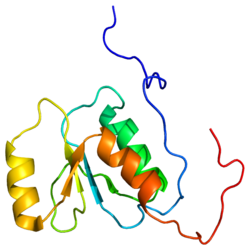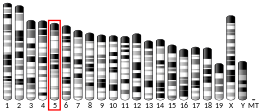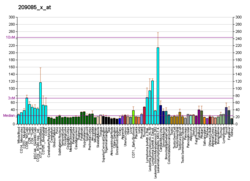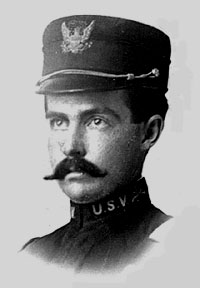RFC1
RFC1| RFC1 | |||||||||||||||||||||||||
|---|---|---|---|---|---|---|---|---|---|---|---|---|---|---|---|---|---|---|---|---|---|---|---|---|---|
 | |||||||||||||||||||||||||
| |||||||||||||||||||||||||
| 식별자 | |||||||||||||||||||||||||
| 별칭 | RFC1, A1 소스, 복제 계수 C 하위 단위 1, MHCBFB, RFC, RECC1, A1, RFC140, PO-GA, 캔버스 | ||||||||||||||||||||||||
| 외부 ID | OMIM: 102579 MGI: 97891 HomoloGene: 2187 GeneCard: RFC1 | ||||||||||||||||||||||||
| |||||||||||||||||||||||||
| |||||||||||||||||||||||||
| |||||||||||||||||||||||||
| 직교체 | |||||||||||||||||||||||||
| 종 | 인간 | 마우스 | |||||||||||||||||||||||
| 엔트레스 | |||||||||||||||||||||||||
| 앙상블 | |||||||||||||||||||||||||
| 유니프로트 | |||||||||||||||||||||||||
| RefSeq(mRNA) | |||||||||||||||||||||||||
| RefSeq(단백질) | |||||||||||||||||||||||||
| 위치(UCSC) | Chr 4: 39.29 – 39.37Mb | Cr 5: 65.42 – 65.49Mb | |||||||||||||||||||||||
| PubMed 검색 | [3] | [4] | |||||||||||||||||||||||
| 위키다타 | |||||||||||||||||||||||||
| |||||||||||||||||||||||||
복제인자 C 하위단위 1은 인간에서 RFC1 유전자에 의해 암호화된 단백질이다.[5][6]
함수
이 유전자에 의해 인코딩된 단백질은 복제인자 C의 큰 서브 유닛으로, 5개의 서브 유닛 DNA 중합효소 부속 단백질이다.복제인자 C는 진핵 DNA 복제와 수리에 필요한 DNA 의존형 ATPase이다.단백질은 DNA 중합체의 활성제 역할을 하며, 프라이머의 3의 끝에 결합하며, 양쪽 가닥의 공동 합성을 촉진한다.그것은 또한 말단소립 안정에도 역할을 할 수 있다.[6]
상호작용
RFC1은 다음과 상호 작용하는 것으로 나타났다.
임상 관련성
복제인자 C 서브유닛 1(RFC1) 유전자의 바이알렐릭 인트로닉 반복팽창(일련의 반복 핵분열)은 소뇌 아탁시아, 신경병증, 전정맥아플렉스증후군(CANVAS)을 유발한다.[17]RFC1에 있는 AluSx3 원소의 폴리(A) 꼬리 내에는 펜타뉴클레오티드 "AAAG"의 11회 반복이 있다.모집단의 일부에서 반복 팽창 및 다형성 구성이 관찰되며, 대체 "AAGG", "AAGGG" 및 "ACAG" 펜타뉴클레오티드와 관련된 반복 횟수가 증가한다.[18]특히 캔버스 환자에선 바이알릭 'AAGGG'와 'ACAGG' 반복 확장이 불균형적으로 관찰됐다.바이알렐릭 "AAGGG" 반복 확장은 또한 산발적으로 나타나는 후기성 아탁시아,[17] 감각 신경증[19][20], 그리고 소뇌 아탁시아를 분리하는 경우가 많은 것으로 보고되고 있다.[21]캔버스와 중복되는 진단으로 인해, 연구자들은 또한 병리학적으로 확인된 다중 시스템 위축(MSA)에서 RFC1 확장의 존재를 조사했지만, 건강한 모집단과 유사한 변화 빈도(0.7%)를 발견했는데, 이는 RFC1이 이 질병에 대한 역할이 없음을 시사한다.[22]
돌연변이 바이알렐릭 인트로닉 반복 확장은 환자 주변 및 뇌 조직에서 RFC1 발현에 영향을 주지 않으며, 이는 이 유전자의 명백한 기능 상실이 없음을 시사한다.[17]
병원성 RFC1 확장 환자의 경우 감각 신경증이 주요 특징으로 보이며, 소뇌 기능 장애, 전정 관여, 건성 경련성 기침 등의 증상이 나타날 수 있으므로 이러한 증상이 있는 환자에게는 유전자 검사를 권고한다.[23]
참조
- ^ a b c GRCh38: 앙상블 릴리스 89: ENSG00000035928 - 앙상블, 2017년 5월
- ^ a b c GRCm38: 앙상블 릴리스 89: ENSMUSG000029191 - 앙상블, 2017년 5월
- ^ "Human PubMed Reference:". National Center for Biotechnology Information, U.S. National Library of Medicine.
- ^ "Mouse PubMed Reference:". National Center for Biotechnology Information, U.S. National Library of Medicine.
- ^ Luckow B, Bunz F, Stillman B, Lichter P, Schütz G (March 1994). "Cloning, expression, and chromosomal localization of the 140-kilodalton subunit of replication factor C from mice and humans". Molecular and Cellular Biology. 14 (3): 1626–34. doi:10.1128/mcb.14.3.1626. PMC 358521. PMID 8114700.
- ^ a b "Entrez Gene: RFC1 replication factor C (activator 1) 1, 145kDa".
- ^ a b Maruyama T, Farina A, Dey A, Cheong J, Bermudez VP, Tamura T, et al. (September 2002). "A Mammalian bromodomain protein, brd4, interacts with replication factor C and inhibits progression to S phase". Molecular and Cellular Biology. 22 (18): 6509–20. doi:10.1128/mcb.22.18.6509-6520.2002. PMC 135621. PMID 12192049.
- ^ Anderson LA, Perkins ND (August 2002). "The large subunit of replication factor C interacts with the histone deacetylase, HDAC1". The Journal of Biological Chemistry. 277 (33): 29550–4. doi:10.1074/jbc.M200513200. PMID 12045192.
- ^ Fotedar R, Mossi R, Fitzgerald P, Rousselle T, Maga G, Brickner H, et al. (August 1996). "A conserved domain of the large subunit of replication factor C binds PCNA and acts like a dominant negative inhibitor of DNA replication in mammalian cells". The EMBO Journal. 15 (16): 4423–33. doi:10.1002/j.1460-2075.1996.tb00815.x. PMC 452166. PMID 8861969.
- ^ Mossi R, Jónsson ZO, Allen BL, Hardin SH, Hübscher U (January 1997). "Replication factor C interacts with the C-terminal side of proliferating cell nuclear antigen". The Journal of Biological Chemistry. 272 (3): 1769–76. doi:10.1074/jbc.272.3.1769. PMID 8999859.
- ^ van der Kuip H, Carius B, Haque SJ, Williams BR, Huber C, Fischer T (April 1999). "The DNA-binding subunit p140 of replication factor C is upregulated in cycling cells and associates with G1 phase cell cycle regulatory proteins". Journal of Molecular Medicine. 77 (4): 386–92. doi:10.1007/s001090050365. PMID 10353443. S2CID 22183443.
- ^ Ohta S, Shiomi Y, Sugimoto K, Obuse C, Tsurimoto T (October 2002). "A proteomics approach to identify proliferating cell nuclear antigen (PCNA)-binding proteins in human cell lysates. Identification of the human CHL12/RFCs2-5 complex as a novel PCNA-binding protein". The Journal of Biological Chemistry. 277 (43): 40362–7. doi:10.1074/jbc.M206194200. PMID 12171929.
- ^ Anderson LA, Perkins ND (January 2003). "Regulation of RelA (p65) function by the large subunit of replication factor C". Molecular and Cellular Biology. 23 (2): 721–32. doi:10.1128/mcb.23.2.721-732.2003. PMC 151544. PMID 12509469.
- ^ Ellison V, Stillman B (March 1998). "Reconstitution of recombinant human replication factor C (RFC) and identification of an RFC subcomplex possessing DNA-dependent ATPase activity". The Journal of Biological Chemistry. 273 (10): 5979–87. doi:10.1074/jbc.273.10.5979. PMID 9488738.
- ^ Uhlmann F, Cai J, Flores-Rozas H, Dean FB, Finkelstein J, O'Donnell M, Hurwitz J (June 1996). "In vitro reconstitution of human replication factor C from its five subunits". Proceedings of the National Academy of Sciences of the United States of America. 93 (13): 6521–6. Bibcode:1996PNAS...93.6521U. doi:10.1073/pnas.93.13.6521. PMC 39056. PMID 8692848.
- ^ Tomida J, Masuda Y, Hiroaki H, Ishikawa T, Song I, Tsurimoto T, et al. (April 2008). "DNA damage-induced ubiquitylation of RFC2 subunit of replication factor C complex". The Journal of Biological Chemistry. 283 (14): 9071–9. doi:10.1074/jbc.M709835200. PMC 2431014. PMID 18245774.
- ^ a b c Cortese A, Simone R, Sullivan R, Vandrovcova J, Tariq H, Yau WY, et al. (May 2019). "Author Correction: Biallelic expansion of an intronic repeat in RFC1 is a common cause of late-onset ataxia". Nature Genetics. 51 (5): 920. doi:10.1038/s41588-019-0422-y. PMC 6730635. PMID 31028356.
- ^ Scriba CK, Beecroft SJ, Clayton JS, Cortese A, Sullivan R, Yau WY, Dominik N, Rodrigues M, Walker E, Dyer Z, Wu TY, Davis MR, Chandler DC, Weisburd B, Houlden H, Reilly MM, Laing NG, Lamont PJ, Roxburgh RH, Ravenscroft G (October 2020). "A novel RFC1 repeat motif (ACAGG) in two Asia-Pacific CANVAS families". Brain. 143 (10): 2904–10. doi:10.1093/brain/awaa263. PMC 7780484. PMID 33103729.
- ^ Tagliapietra M, Cardellini D, Ferrarini M, Testi S, Ferrari S, Monaco S, Cavallaro T, Fabrizi GM (April 2021). "RFC1 AAGGG repeat expansion masquerading as Chronic Idiopathic Axonal Polyneuropathy". Journal of Neurology. 268 (11): 4280–4290. doi:10.1007/s00415-021-10552-3. PMC 8505379. PMID 33884451.
- ^ Currò R, Salvalaggio A, Tozza S, Gemelli C, Dominik N, Galassi Deforie V, Magrinelli F, Castellani F, Vegezzi E, Businaro P, Callegari I, Pichiecchio A, Cosentino G, Alfonsi E, Marchioni E, Colnaghi S, Gana S, Valente EM, Tassorelli C, Efthymiou S, Facchini S, Carr A, Laura M, Rossor AM, Manji H, Lunn MP, Pegoraro E, Santoro L, Grandis M, Bellone E, Beauchamp NJ, Hadjivassiliou M, Kaski D, Bronstein AM, Houlden H, Reilly MM, Mandich P, Schenone A, Manganelli F, Briani C (June 2021). "RFC1 expansions are a common cause of idiopathic sensory neuropathy". Brain. 144 (5): 2904–10. doi:10.1093/brain/awab072. ISSN 0006-8950. PMC 8262986. PMID 33969391.
- ^ Traschütz A, Cortese A, Reich S, Dominik N, Faber J, Jacobi H, et al. (Group R study) (March 2021). "Natural History, Phenotypic Spectrum, and Discriminative Features of Multisystemic RFC1-disease". Neurology. 96 (9): e1369–e1382. doi:10.1212/WNL.0000000000011528. PMC 8055326. PMID 33495376.
- ^ Sullivan R, Yau WY, Chelban V, Rossi S, O'Connor E, Wood NW, et al. (April 2020). "RFC1 Intronic Repeat Expansions Absent in Pathologically Confirmed Multiple Systems Atrophy". Movement Disorders. 35 (7): 1277–1279. doi:10.1002/mds.28074. PMID 32333430. S2CID 216129457.
- ^ Cortese A, Tozza S, Yau WY, Rossi S, Beecroft SJ, Jaunmuktane Z, et al. (February 2020). "Cerebellar ataxia, neuropathy, vestibular areflexia syndrome due to RFC1 repeat expansion". Brain. 143 (2): 480–490. doi:10.1093/brain/awz418. PMC 7009469. PMID 32040566.
추가 읽기
- Lu Y, Riegel AT (August 1994). "The human DNA-binding protein, PO-GA, is homologous to the large subunit of mouse replication factor C: regulation by alternate 3' processing of mRNA". Gene. 145 (2): 261–5. doi:10.1016/0378-1119(94)90017-5. PMID 7914507.
- Bunz F, Kobayashi R, Stillman B (December 1993). "cDNAs encoding the large subunit of human replication factor C". Proceedings of the National Academy of Sciences of the United States of America. 90 (23): 11014–8. Bibcode:1993PNAS...9011014B. doi:10.1073/pnas.90.23.11014. PMC 47912. PMID 8248204.
- Lu Y, Zeft AS, Riegel AT (June 1993). "Cloning and expression of a novel human DNA binding protein, PO-GA". Biochemical and Biophysical Research Communications. 193 (2): 779–86. doi:10.1006/bbrc.1993.1693. PMID 8512577.
- Uhlmann F, Cai J, Flores-Rozas H, Dean FB, Finkelstein J, O'Donnell M, Hurwitz J (June 1996). "In vitro reconstitution of human replication factor C from its five subunits". Proceedings of the National Academy of Sciences of the United States of America. 93 (13): 6521–6. Bibcode:1996PNAS...93.6521U. doi:10.1073/pnas.93.13.6521. PMC 39056. PMID 8692848.
- Fotedar R, Mossi R, Fitzgerald P, Rousselle T, Maga G, Brickner H, et al. (August 1996). "A conserved domain of the large subunit of replication factor C binds PCNA and acts like a dominant negative inhibitor of DNA replication in mammalian cells". The EMBO Journal. 15 (16): 4423–33. doi:10.1002/j.1460-2075.1996.tb00815.x. PMC 452166. PMID 8861969.
- Uchiumi F, Ohta T, Tanuma S (December 1996). "Replication factor C recognizes 5'-phosphate ends of telomeres". Biochemical and Biophysical Research Communications. 229 (1): 310–5. doi:10.1006/bbrc.1996.1798. PMID 8954124.
- Mossi R, Jónsson ZO, Allen BL, Hardin SH, Hübscher U (January 1997). "Replication factor C interacts with the C-terminal side of proliferating cell nuclear antigen". The Journal of Biological Chemistry. 272 (3): 1769–76. doi:10.1074/jbc.272.3.1769. PMID 8999859.
- Cujec TP, Cho H, Maldonado E, Meyer J, Reinberg D, Peterlin BM (April 1997). "The human immunodeficiency virus transactivator Tat interacts with the RNA polymerase II holoenzyme". Molecular and Cellular Biology. 17 (4): 1817–23. doi:10.1128/mcb.17.4.1817. PMC 232028. PMID 9121429.
- Ubeda M, Habener JF (August 1997). "The large subunit of the DNA replication complex C (DSEB/RF-C140) cleaved and inactivated by caspase-3 (CPP32/YAMA) during Fas-induced apoptosis". The Journal of Biological Chemistry. 272 (31): 19562–8. doi:10.1074/jbc.272.31.19562. PMID 9235961.
- Rhéaume E, Cohen LY, Uhlmann F, Lazure C, Alam A, Hurwitz J, et al. (November 1997). "The large subunit of replication factor C is a substrate for caspase-3 in vitro and is cleaved by a caspase-3-like protease during Fas-mediated apoptosis". The EMBO Journal. 16 (21): 6346–54. doi:10.1093/emboj/16.21.6346. PMC 1170241. PMID 9351817.
- Ellison V, Stillman B (March 1998). "Reconstitution of recombinant human replication factor C (RFC) and identification of an RFC subcomplex possessing DNA-dependent ATPase activity". The Journal of Biological Chemistry. 273 (10): 5979–87. doi:10.1074/jbc.273.10.5979. PMID 9488738.
- Coll JM, Hickey RJ, Cronkey EA, Jiang HY, Schnaper L, Lee MY, et al. (1998). "Mapping specific protein-protein interactions within the core component of the breast cell DNA synthesome". Oncology Research. 9 (11–12): 629–39. PMID 9563011.
- Allen BL, Uhlmann F, Gaur LK, Mulder BA, Posey KL, Jones LB, Hardin SH (September 1998). "DNA recognition properties of the N-terminal DNA binding domain within the large subunit of replication factor C". Nucleic Acids Research. 26 (17): 3877–82. doi:10.1093/nar/26.17.3877. PMC 147807. PMID 9705493.
- van der Kuip H, Carius B, Haque SJ, Williams BR, Huber C, Fischer T (April 1999). "The DNA-binding subunit p140 of replication factor C is upregulated in cycling cells and associates with G1 phase cell cycle regulatory proteins". Journal of Molecular Medicine. 77 (4): 386–92. doi:10.1007/s001090050365. PMID 10353443. S2CID 22183443.
- Wang Y, Cortez D, Yazdi P, Neff N, Elledge SJ, Qin J (April 2000). "BASC, a super complex of BRCA1-associated proteins involved in the recognition and repair of aberrant DNA structures". Genes & Development. 14 (8): 927–39. doi:10.1101/gad.14.8.927. PMC 316544. PMID 10783165.
- Yazdi PT, Wang Y, Zhao S, Patel N, Lee EY, Qin J (March 2002). "SMC1 is a downstream effector in the ATM/NBS1 branch of the human S-phase checkpoint". Genes & Development. 16 (5): 571–82. doi:10.1101/gad.970702. PMC 155356. PMID 11877377.
- Anderson LA, Perkins ND (August 2002). "The large subunit of replication factor C interacts with the histone deacetylase, HDAC1". The Journal of Biological Chemistry. 277 (33): 29550–4. doi:10.1074/jbc.M200513200. PMID 12045192.
- Ohta S, Shiomi Y, Sugimoto K, Obuse C, Tsurimoto T (October 2002). "A proteomics approach to identify proliferating cell nuclear antigen (PCNA)-binding proteins in human cell lysates. Identification of the human CHL12/RFCs2-5 complex as a novel PCNA-binding protein". The Journal of Biological Chemistry. 277 (43): 40362–7. doi:10.1074/jbc.M206194200. PMID 12171929.
- Maruyama T, Farina A, Dey A, Cheong J, Bermudez VP, Tamura T, et al. (September 2002). "A Mammalian bromodomain protein, brd4, interacts with replication factor C and inhibits progression to S phase". Molecular and Cellular Biology. 22 (18): 6509–20. doi:10.1128/MCB.22.18.6509-6520.2002. PMC 135621. PMID 12192049.








